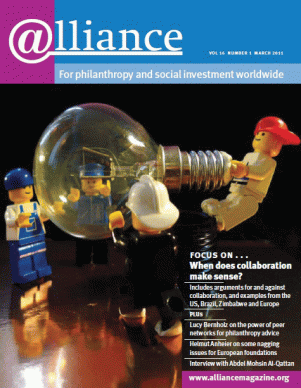No doubt Paul Shoemaker intends to provoke in his article ‘Raising the bar for philanthropy’ (December 2010). Taking the bait … in the legal world, the client pays for legal services, so reputation and word of mouth are essential, and incompetent lawyers seldom thrive. The same is true in the embryonic market of philanthropy advice, and undoubtedly finding a way to develop training and set standards for advisers is to be welcomed.
But he elides this with the suggestion of some form of ‘certification’ for philanthropists, while at the same time recognizing that giving is voluntary, and the practice of philanthropy should not be regulated.
Assuming that this ‘certification’ goes beyond honorary recognition (for example the Carnegie medal or the Beacon awards), the purpose is unclear. Does he expect non-profit organizations to accept funding only from ‘certified philanthropists’? Would the money somehow be more useful? Is he suggesting that one can’t apply the term ‘philanthropist’ unless the person concerned has some kind of certification? Should journalists check? Are ‘certified’ philanthropists those who conform to currently fashionable ideas of how to effect social change? (We only have to look at the world of international development to see how ideas of what constitutes ‘effective intervention’ have changed.)
Of course there are various ways in which donors can learn on a formal basis. In the UK this might be through courses such as The Philanthropy Workshop or events organized by, for example, the Community Foundation Network or through the issue based networks of the Association of Charitable Foundations. And it is never too young to learn – there are interesting pilot projects in schools. But most donors go on a journey. They learn with practice, they visit projects, they ask questions – and they learn most when there are constructive relationships based on mutual respect and understanding with the organizations they fund. The practice of ‘effective, thoughtful, informed philanthropy’ would be hugely enhanced if more non-profits saw their major donors as genuine partners and produced accessible, transparent and honest feedback.
The idea that such donors will attend university courses is a fantasy for all but a tiny minority, but every single non-profit has a responsibility to contribute to better-informed and more effective philanthropy. The term ‘donor education’ may no longer be fashionable but that is what this is about.
And what about the competence of non-profits? Many donors and their advisers would argue that anyone can ‘hang out their shingle’ and set themselves up as an NGO. Is he proposing ‘certification’ for them? Shoemaker identifies the challenge of the imperfect marketplace faced by those seeking funding. In both the for-profit and the non-profit sectors, larger organizations seeking funding will have close links with major institutional investors while smaller companies find it more difficult. What he seems to be complaining about is that those seeking philanthropic investment must undertake research and present clear plans and be able to show the likely impact of further funding. This is a good discipline. What is so inefficient about that?
Theresa Lloyd
Theresa Lloyd Associates






Comments (0)